Disclosure: Some posts contain affiliate links, which earn us a commission if you make a purchase through them. Positive Fishing © participates in various affiliate networks including the Amazon Services LLC Associates Program.
Fly fishing for predatory fish, whether you’re chasing pike in freshwater, tarpon in the Atlantic, or GTs in the Indian Ocean, is one of the most exciting forms of fly fishing, in my opinion.
Watching a tarpon sip your fly, a GT come and crash your fly, or a pike hit your fly out of nowhere with a ginormous thump is an adrenaline rush of note. But, to convince these kinds of predators to come and eat, you have to be using the right flies.
5 Key Factors Why Flies Catch Predator Fish
Visibility and Attraction: Predator fish rely on their keen senses to hunt, so flies that are highly visible or create significant movement in the water can be particularly effective. Bright colors and reflective materials are best used in murky water or low-light conditions, while flies with built-in noise, such as those with rattles or surface poppers, draw attention through sound. Additionally, flies that create a disturbance or a visible wake on the surface will trigger aggressive strikes.
Match the Hatch and Baitfish: Predator fish are often opportunistic feeders that target prey species found in their local environment. Choose flies that closely imitate the natural prey’s size, shape, and color, such as baitfish, frogs, or crabs. Known as “matching the hatch,” it increases the likelihood of attracting their attention. For example, streamers mimic the swimming action of small fish, and larger, articulated flies simulate the movement of bigger prey.
Size Matters: The size of the fly can be a critical factor when targeting predator fish. Bigger flies are often more effective because larger fish can see them from a greater distance. However, it’s important to match the size of the fly to the size of the prey fish they eat naturally. Sometimes, especially when fish are finicky, changing to a smaller fly can be the key to getting bites.
Action and Mobility: How a fly moves through the water can significantly impact its ability to attract predator fish. Flies creating natural movement using materials such as marabou, rabbit fur, or soft synthetic fibers can provide lifelike action even in still water. Adding articulated joints, spinning blades, or foam popper heads increases extra movement, noise, or surface disturbance, making the fly more enticing.
Versatility and Depth Control: Predatory fish can be found at various depths depending on the water temperature, time of day, and available cover. Therefore, having a selection of flies that can be fished at different depths increases your chances of success. Using topwater flies for surface action, intermediate flies for mid-water, and heavily weighted flies with sinking lines for reaching deeper water, cover the range where predators may lurk. Adapting to the feeding patterns of the fish by presenting flies at the right depth is crucial.
My Best Flies For Predator Fishing
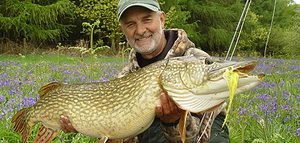
I have spent a career as a professional fly fishing guide all over the world, from the saltwater flats to the Bolivian rivers and the diverse Kenyan rivers and coastline, going after predator fish.
In this article, I will take you through all the best flies to use when fly fishing for predators, whether it’s bass, pike, barracuda, tarpon, GTs, or even billfish.
Brush Fly
The brush fly is the number one type of fly to use when targeting giant trevally on the flats, but it also works well when targeting other species like golden dorado, mahi-mahi, tuna, and more.
Brush flies are usually tied on a 4/0 or 6/0 hook, and it’s best to have them tied on Gamakatsu SL12S hooks, as these handle the salt well and don’t bend under a ton of drag pressure.
Brush flies work so well because they provide an excellent baitfish profile that predatory fish love. They can be quite heavy to cast depending on how much material is on them, coupled with a large hook size, so they are best used with a 10 or 12-weight fly rod.
Brush flies come in a huge range of color combinations, from tan and white to black and purple. These two color combinations are some of the most deadly when fishing for GTs on the flats.
Magnetic Minnow
The magnetic minnow is one of the most effective brush flies on the planet, and many a 100+cm GT has been caught on one of these. They come in a good range of colors, particularly the white and chartreuse or white and tan are prolific.
Flaming Lamborghini
The flaming Lamborghini is another brush fly that has fooled many a GT. This brush fly is bright red with a touch of orange mixed in and seems to get the fish very mad and willing to attack the fly. This is one fly you need to have at least four of in your tackle box when going fly fishing for these large semi-pelagics.
Semper
Semper flies are big flies, and they are made for the biggest of predators, mainly GTs. They are longer and wider than brush flies, therefore creating a larger profile that imitates larger baitfish.
When tied, they have a large hackle at the head and then a long tail running out of the hackles. This makes this fly very heavy to cast, so you had better know how to cast a 12-weight well if you want to fish this fly properly.
You can find semper flies in many different color options, and they usually work best in dark colors like olive, black, purple, and mixtures of these colors, too.
NYAP
The NYAP, which stands for Not Your Average Popper, was designed by a fly fishing guide on Alphonse Island called James Christmas. It is incredibly effective at catching GTs, bohar snappers, and cubera snappers.
It has a different shape from a normal popper, as the foam head has a rectangular front that tapers off to the end of the hook shank to create a good baitfish profile. A tail of buck hair is also tied into the back of the foam to make the fly look realistic.
When fished properly, an NYAP makes a lot of noise and attracts predators to eat it from the depths and long distances.
You can get NYAPs in two different colors, white and black, and it pays to have both in your fly box. I personally prefer black NYAPs as they are much easier for fish to see. I have never thrown one of these for largemouth bass, but I bet it would be incredibly effective.
Double Barrel Popper
The double-barrel popper originates in fly fishing for bass; you can find these in a load of different sizes. The bigger double barrel poppers are great for GTs, tuna, mahi-mahi, and more, while the smaller ones are awesome for barracuda and bass.
These are tied similarly to an NYAP, except the popping head is round with two barrels that catch a ton of water and make plenty of loud noise. The noise it makes is excellent at attracting fish from a long distance.
Like NYAPs, these flies also come with a tail tied in and in black or white colors. To change the color, simply paint over the white popping heads to make them whatever color you prefer.
Clousers
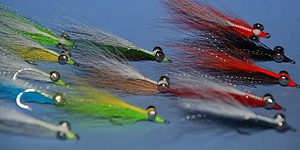
Clousers are a very effective fly to use when fly fishing for predators as they come with dumbbell eyes with a nice baitfish profile behind them. The dumbbell eyes get this fly to sink quickly, meaning you can fish it deeper than other flies like brush flies or sempers.
These flies come in a vast range of colors, and some of the best are two-tone options with blue and white, chartreuse and white, and tan and white.
The one difficulty with clousers is casting them since they are rather heavy flies due to the dumbbell eyes. When casting a Clouser, make sure the wind isn’t coming over your casting shoulder, as it really hurts when the dumbbell eyes hit you in the back or, even worse, your head!
Tarpon Toad
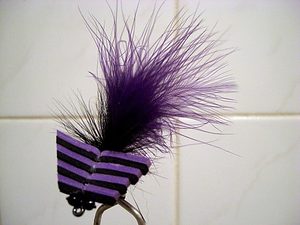
favorite fly for big tarpon
The tarpon toad is one of the most effective flies you can use to catch good-sized tarpons.
They come with a large flat profile around the shank of the hook, which gives them a great profile for fish looking upwards, like tarpon. They also have a short tail tied behind the fly’s body, giving them great action.
You can find these flies in a range of colors, and two-tone options are often best. A combination of black and purple is one of the most effective options you can use, as well as black and red plus tan and white.
Minnow
Minnow flies are excellent for catching predators like snook, striped bass, albacore, bonito, and all the trout family. These flies are made with a special material called Sili Skin, which is a reflective plastic/rubbery material that is usually silver and even feels like a baitfish.
These flies are extremely effective when predators, such as bonefish, feed on newly hatched baitfish, aka minnows. They provide a load of flash, and their action is also excellent to fool feeding predators every time on a good cast.
Minnow flies usually come in silver color but can have a tint to them, and the best options include pearl, green, and blue. They are all pretty effective, but it is always worthwhile having a range of options in your fly box.
Articulated Streamer
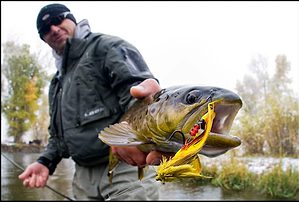
Articulated streamers are big streamer patterns tied with articulation built-in. This is done by extending the length of the fly and tying profile sections down the length. When you strip this fly through the water, it articulates or naturally pulsates like a swimming baitfish.
These flies are usually used to catch the biggest brown or rainbow trout in the river, as these fish generally start eating other fish instead of insects when they grow so big. You can also use them for other species like bass, pike, and muskie.
Again, you will have quite a few different color options to choose from, and in this case, going for some natural colors, such as olive, is best.
Bunny
Bunny flies are tied with a huge hackle at the front and a broad, long tail out the back. The large hackle sections pulsate and push water as you strip the fly, and the long tail has excellent action, which makes it very appealing to fish.
There are many different types of bunny flies on the market, and you can find them tied for different species, including pike, tarpon, and GTs. The main difference between the pre-tied types comes down to the hooks used and the size of the flies.
Merkin Crab
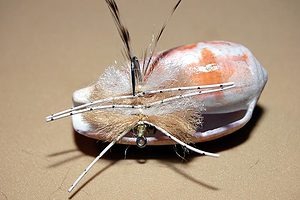
The merkin crab is a big crab fly that is great for catching predators that spend their time patrolling rocky ledges. Species like GTs love this kind of fly when they are hunting on the inshore flats, and it will work for a load of different species, too, as what fish doesn’t eat crabs? Not many, that’s for sure.
It’s tied with a large body and legs, too, which gives it a very realistic profile. You will also find that species like permit and bonefish are partial to these unique flies.
Flexo Crab
The Flexo Crab was designed by Alec Gerbec, previously the head guide on Alphonse Island, Seychelles. This fly single-handedly changed the permit and triggerfish fishing in Seychelles as it is the most realistic-looking crab fly you might ever see.
It is tied using flexo material, usually used to coat electrical wires. This material creates the body, which has dumbbell eyes tied inside it, and the legs of the crab and eyes are made by pulling some chenille fabric through the body and setting it with UV glue.
These flies are deadly when fishing for permit and triggerfish, but every fish will eat them. They are best usually tied to a small size, so you don’t want to cast these at big predators.
Check out my in-depth article on How to catch a triggerfish on the fly for some inside tips to learn more about what gear and fly types are needed to catch these incredibly attractive fish.
Flying Out
Thanks very much for reading my article. I hope you enjoyed it and now have a great, proven choice of the best flies for fly fishing for predators, so be sure to fill up your fly box with a range of different colors of each type.
Please share the article with your fishing mates and check out some of our other articles, especially the Best Fly Fishing Saltwater Rods and my review of the superb Abel SDS Ported Saltwater Fly Reel!
- Seeing Clearly: Why Anglers Should Buy Fortis Wraps Fishing Sunglasses - January 25, 2024
- Night Fishing Preparation: 9 Top Tips For A Successful Outing - November 29, 2022
- The Angler’s Edge: How To Sharpen Your Fishing Hooks Like a Pro - November 23, 2022


